light AUDI A6 2012 Workshop Manual
[x] Cancel search | Manufacturer: AUDI, Model Year: 2012, Model line: A6, Model: AUDI A6 2012Pages: 298, PDF Size: 74.43 MB
Page 90 of 298

88 Audi side a ssis t
- Side assist signal does not work around
t ight corners (turning radius less than
328 feet or 100 m).
- Side assist is no rep lacement for the driv­
er's full attent ion. The dr iver alone is re­
sponsible for lane changes and similar dr iv ing maneuvers . Always keep an eye
on the di rection yo u are traveling and the
relevant area around the vehicle.
(D Note
- To ensure that you do not adversely af­
fect side assist, do not block the area on
the rear bumper whe re the radar sensors
are located with foreign objects (such as
stickers o r bicy cle racks).
- Make sure that the signa l light on the
outside m irror is not blo cked by st ickers
or other items.
@ Tips
- Side assist a utomat ica lly deactivates if it
detects that the radar sensors a re
blocked E} page 93. The ind icator light
on the bu tton goes out.
- The area on the bumper where the radar
sensors are located must consis tently re­
main free of snow, ice, and heavy soiling
so that side assist can function properly .
Fo llow the additional notes on
c> page 93.
-Additional tinting on the front side win­
dows can make it harder to see and cor­
rectly understand the signa l light on the
outside mirror.
- For Declarat ion of Compliance to United
States FCC and Industry Canada regula­
tions
c> page 281.
Sensor detection area
Applies to veh icles: w ith side assist
F ig. 89 Schemat ic ill ust rat ion : Sensor detect ion a rea
The detection c> fig. 89 of the radar sensor de­
tection area is made up of:
- the approach area (light red area)
(D , about
230 feet (70 m) behind the vehicle, and
- the "b lind spot" (dark red area)@.
T he rada r sensors cover the adjace nt left and
right lanes. Other lanes a re
not covered by the
radar sensors.
(0 Tips
Side assist does not measure a ctual lane
wid th. The system assumes a fixe d lane
width. Detection in the left and right lanes
is based on this assumed lane width .
When driv ing on narrow roads or when
driving to the left or right of the center of
a travel lane, it is possible that vehicles
will be detected that are
not in the lane
next to the lane you are us ing
c> page 92.
Operation
Applies to veh icles: w ith s ide assist
S ide assist compares t he d istance and diffe r­
ence in speed of detected vehicles wi th the
speed of your vehi cle. Wheneve r the d iffe r­
ence in speed and distance is registered as no ­
tab le if you were to change lanes, a signal
li ght appears on the respective mirror.
T he signa l can ligh t up if yo u are passed by a
vehicle or if you are passing another vehicle.
If you pass another vehi cle slowly (difference
in speed less than 9 mph, o r 15 km/h), the ..,.
Page 91 of 298
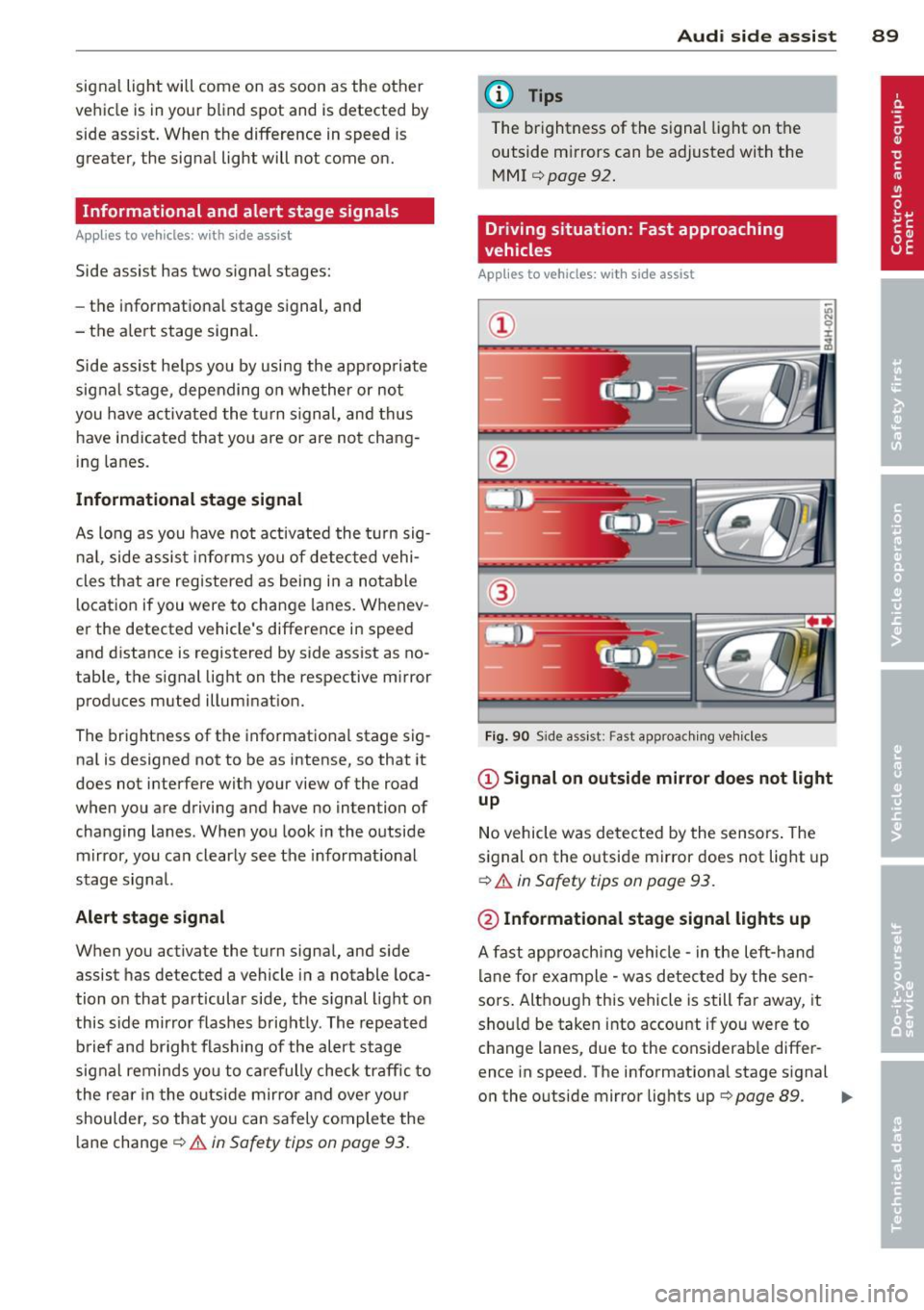
signal light will come on as soon as the other
vehicle is in your blind spot and is detected by
side assist. When the difference in speed is
greater, the signa l light will not come on.
Informational and alert stage signals
App lies to vehicles: with side assist
Side assis t has two s ignal stages:
- the informationa l stage signal, and
- the a le rt stage signa l.
Side assist he lps you by usi ng the approp riate
signal s tage, depending on whether or not
you have activ ated the tu rn signal, and thus
have indicated that you are or are not chang ­
ing lanes .
Informational stage signal
As long as you have not a ctivated the tu rn sig­
n al , side a ssis t inf orms you of detec ted vehi­
cles th at are registered as being in a notable
l ocation if you were to change lanes. Whenev­
er the detected vehicle's difference i n speed
and d istance is registered by side assist as no­
table, the signal lig ht on the respective m irror
prod uces muted illuminat ion.
The brightness of the informat io na l stage sig ­
na l is designed not to be as intense, so that it
does not interfere wit h your view of the road
when you are driving and have no intention of
changing lanes. When you look in the o utside
mirror, you can clear ly see the info rmat iona l
stage signal.
Alert stage signal
When you activate the turn signa l, and side
assist has detec ted a vehicle i n a notable loca­
tion o n that particular side, the s ignal l ight on
this sid e mirro r flashes b right ly . The repeated
b rie f and bright flashing of the alert stage
signal re minds yo u to carefully check tr aff ic to
the rear in the o utside mirror and ove r your
shoulder, so that yo u can safe ly complete the
l ane change
c:> & in Safety tips on page 93.
Aud i side assist 89
@ Tips
The br ightness of the s ignal li ght on the
outside m irr ors can be adjusted with the
MMI c:> page 92.
Driving situation: Fast approaching
vehicles
Applies to vehicles: with side assist
@
Fig. 9 0 Side as sis t: Fast approac hing ve hicle s
@ Signal on outside mirror does not light
up
No vehicle was detecte d by the sensors . The
s ignal on the o utside mirror does not lig ht up
c:> .&. in Safety tips on page 93 .
@ Informational stage signal lights up
A fast appro ach ing vehicle -in the left-h and
l ane fo r example - was detected by the sen­
sors . Although this vehicle is still fa r away, it
sho uld be taken into accou nt if yo u were to
c hange lanes, due to the cons iderab le differ­
ence in speed. The informationa l stage s ignal
o n the outside mirror lig hts up
r=> page 89. ..,.
Page 92 of 298
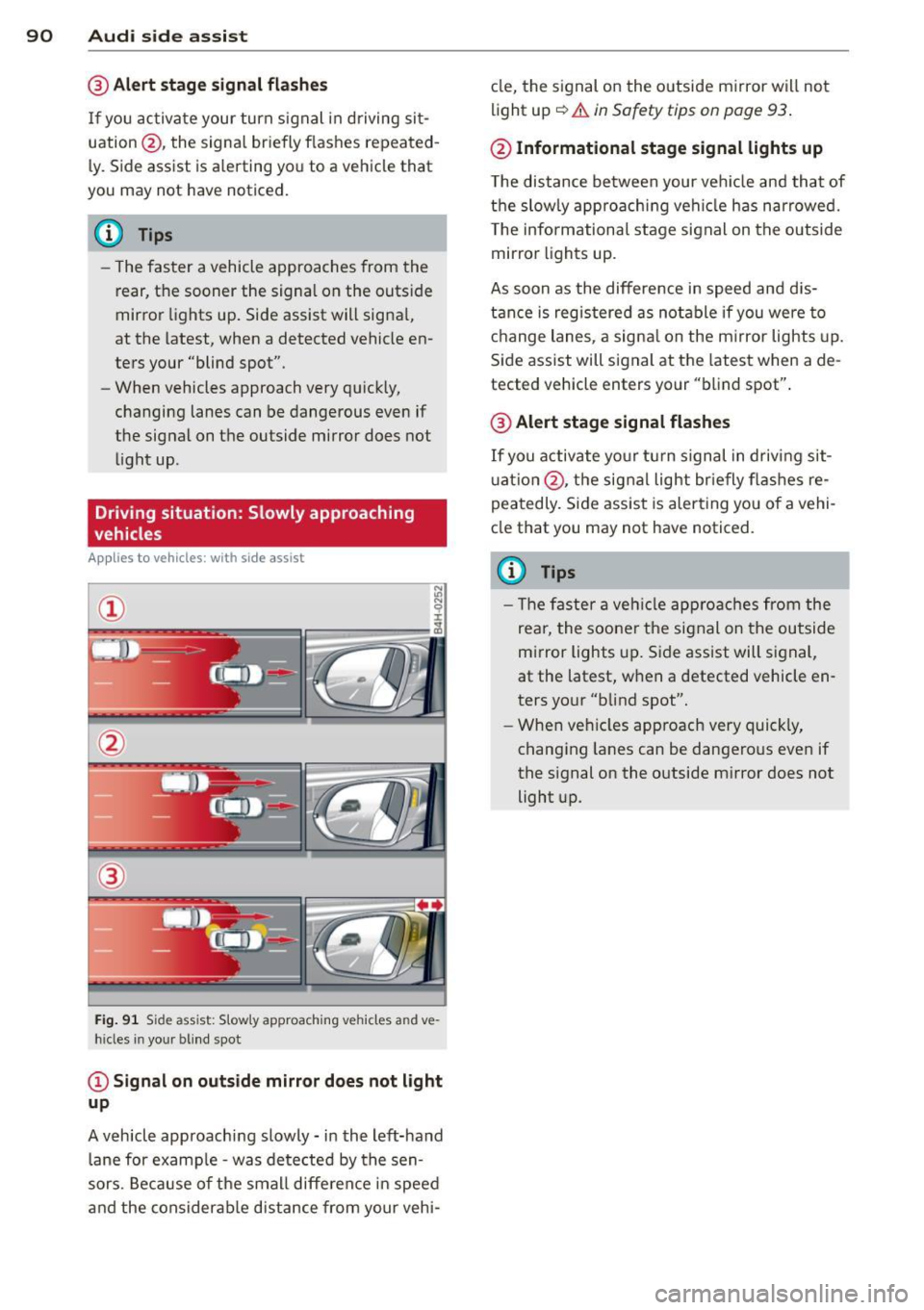
90 Audi side assist
@ Alert stage signal flashes
If you activate your turn signal in driving sit ­
uation @, th e signa l br iefly f lashes repeated­
l y. Side assist is a lerting yo u to a vehicle that
you may not have noticed.
@ Tips
- The faster a vehicle approaches from the
rear, the sooner the signa l on the outs ide
mirror lights up. Side assist will signa l,
at the latest, when a detected vehicle en­
ters your "blind spot".
- When vehicles approach very quickly,
changing lanes can be dangerous even if
the signal on the outside mirror does not
li ght up.
Driving situation: Slowly approaching
vehicles
Applies to vehicles : w it h side ass ist
¬ģ
Fig. 91 S ide ass ist: S lowly approaching vehicles and ve­
hicles in your blind spot
© Signal on outside mirror does not light
up
A vehicle approaching slowly -in the left-hand
lane for example -was detected by the sen­
sors. Because of the small difference in speed
and the considerab le distance from your vehi- cle,
the signal on the outside mirror will not
light up
c::> &. in Safety tips on page 93 .
@ Informational stage signal lights up
The distance between your vehicle and that of
the slowly approaching vehi cle has narrowed.
T he informational stage signal on the outside
mirror lights up.
As soon as the difference in speed and dis­
tance is registered as notable if you were to
change lanes, a signal on the mirror lights up.
Side assist will signal at the latest when a de­
tected vehicle enters your "blind spot".
@ Alert stage signal flashes
If you activate your turn signal in driving sit­
uation @, the signal light br ie fly flashes re­
peatedly. Side assist is alerting you of a vehi­
cle that you may not have noticed.
(D Tips
- Th e faster a veh icle approaches from the
rea r, the sooner the signal on the outside
mirror lights up. Side assist will signal,
at the latest, when a detected vehicle en­
ters your "blind spot".
- When vehicles app roach very quickly,
changing lanes can be dangero us even if
the signal on the outside mirror does not light up.
Page 93 of 298
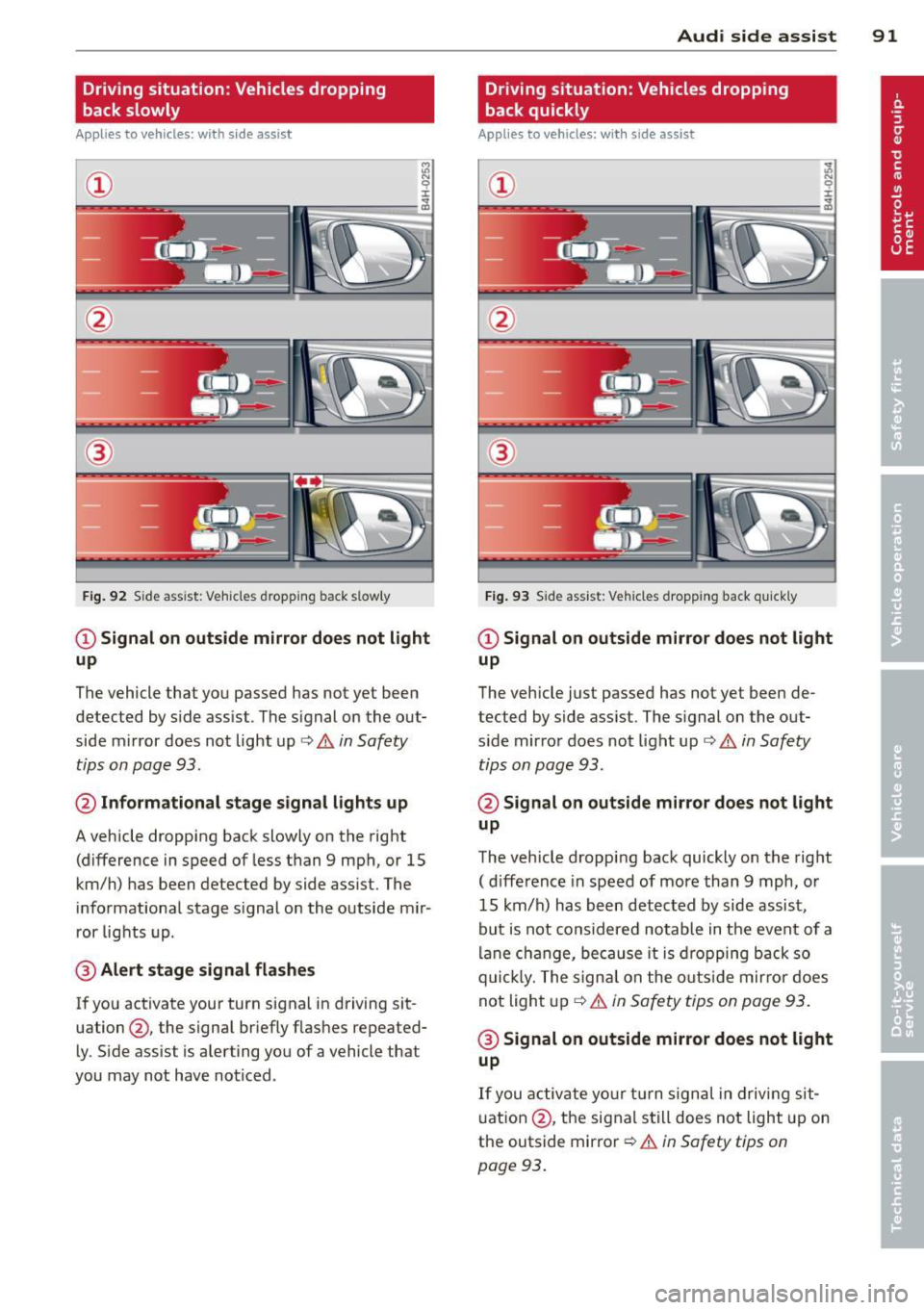
Driving situation: Vehicles dropping
back slowly
Applies to vehicles: with s ide assis t
~ 9 I
---- ----:~
¬ģ
Fig . 92 S ide ass ist: Vehicles dropping back s low ly
CD Signal on outside mirror does not light
up
The vehicle that you passed has not yet been
detected by side assist. The signal on the out­
side mirror does not light up ¬Ę
& in Safety
tips on page 93.
@ Informational stage signal lights up
A vehicle dropping back slowly on the right
(difference in speed of less than 9 mph, or 15
km/h) has been detected by side assist. The
informational stage s ignal on the outside mir­
ror lights up.
@ Alert stage signal flashes
If you activate your turn signal in driving sit­
uation @, the signal briefly flashes repeated­
ly. Side assist is alerting you of a vehicle that
you may not have noticed.
Audi side assist 91
Driving situation: Vehicles dropping
back quickly
Applies to vehicles: wi th side assist
¬ģ
Fig. 93 Side assist: Vehicles dropping back qui ck ly
CD Signal on outside mirror does not light
up
The vehicle just passed has not yet been de­
tected by side assist. The signal on the out­
side mirror does not light up ¬Ę
& in Safety
tips on page 93 .
@ Signal on outside mirror does not light
up
The vehicle dropping back quickly on the right
( d ifference in speed of more than 9 mph, or
15 km/h) has been detected by side assist,
but is not considered notable in the event of a
lane change, because it is dropping back so
quickly. The signa l on the outs ide mirror does
not light up
Q &. in Safety tips on page 93.
@ Signal on outside mirror does not light
up
If you activate your turn signal in driving sit­
uation @, the signal still does not light up on
the outside mirror
Q & in Safety tips on
page 93.
Page 94 of 298
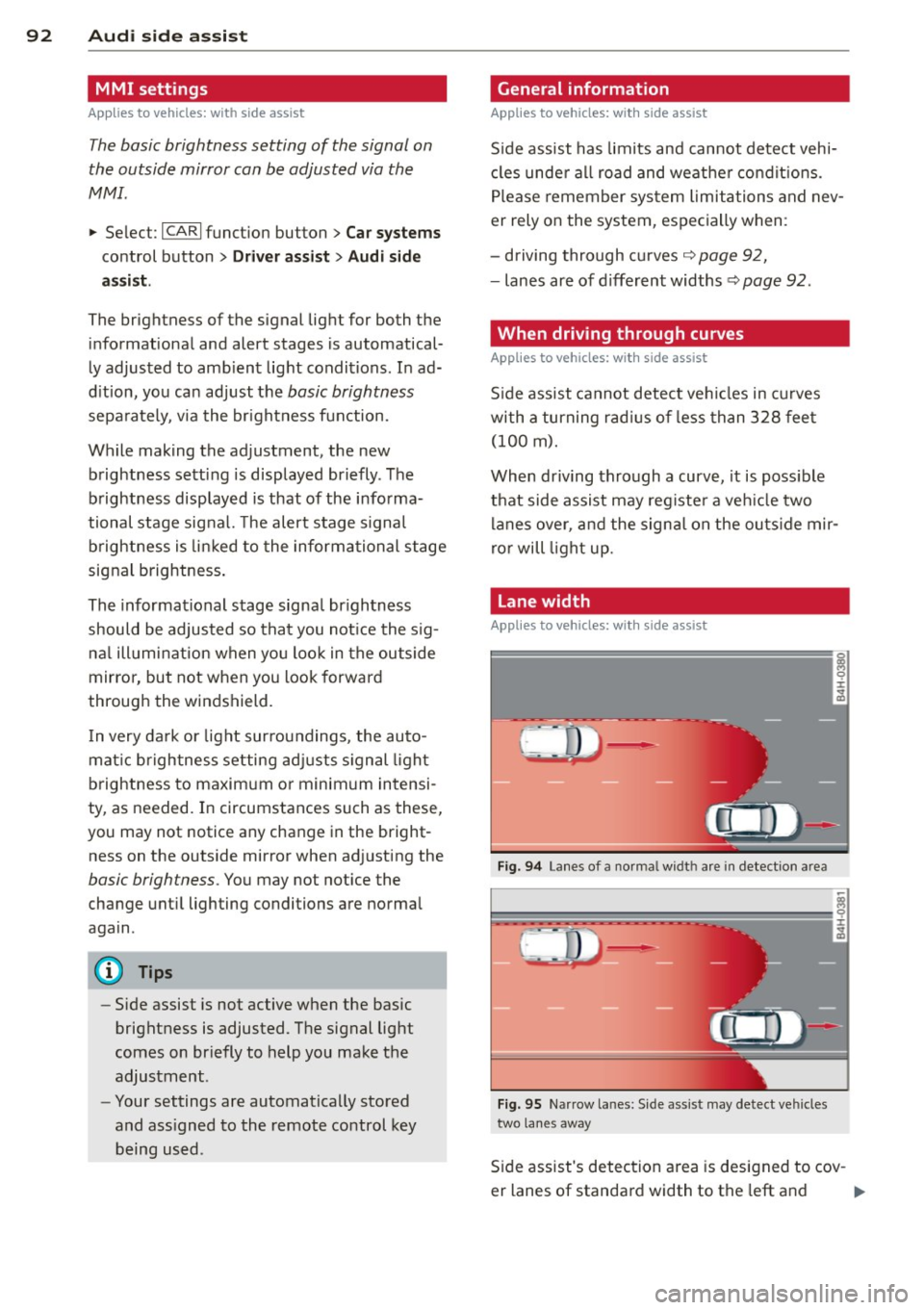
92 Audi side a ssis t
MMI settings
App lies to vehicles: wit h side ass ist
The basic brightness setting of the signal on
the outside mirror can be adjusted via the
MMI.
,. Select : I CARI function button > Car s ystem s
control button > Driver assist > Audi s ide
a ss is t.
The brightness of the signal lig ht for both the
informationa l and alert stages is automatical­
ly adjusted to amb ient light conditions. In ad­
d it ion, you can adjust the
basic brightness
sepa rately, via the brightness fun ction.
While making the adjustment, the new brightness setting is displayed briefly . The
brightness displayed is that of the informa­
tional stage signal. The alert stage signa l
b rightness is lin ked to the informational st age
signal brightness.
The informational stage signa l br ightness
should be adjusted so tha t you not ice the sig­
na l ill uminat ion when yo u loo k in the outside
mirror, but not when you look forward
throug h the windshield.
I n very da rk or light surroundings, the au to­
mat ic brightness setting adjusts s ignal light
brightness to maxim um or minimum intensi­
ty, as needed. In circumstances such as these,
you may not notice any change in the bright­
ness on the outside mirror when ad justing the
basic brightness . You may not notice the
cha nge unt il lighting conditions are norma l
aga in .
(D Tips
- Side assist is not active when the basic
brightness is adjusted. The signal light
comes on br iefly to help you make the
adjustment .
- Your settings are automatically stored
and ass igned to the remote control key
being used.
General information
Applies to veh icles : w it h side assist
S ide assist has limits and cannot dete ct vehi­
cl es unde r all road and weat he r c ondit ions .
Please remember sys tem limita tions and nev­
er rely on the system, especially when :
- driving thro ugh curves ~
page 92,
- lanes are of d ifferent widths~
page 92.
· When driving through curves
Applies to veh icles: w it h side assist
S ide assist cannot detect ve hicles in c urves
with a turning rad ius o f less than 3 28 fee t
(10 0 m).
When driving thro ugh a curve, it is poss ible
that side assist may reg iste r a veh icle two
l anes over, a nd the signa l o n the ou ts ide mir­
ror will ligh t up.
Lane width
Appl ies to veh icles : w ith side assist
0
Fi g. 94 La nes o f a norma l widt h are in detect ion area
Fi g. 95 Narrow la nes: S ide ass ist may detect ve hicles
two lanes away
S ide assist's detec tion a rea is designed to cov -
er lanes of standa rd width to the left and
ll-
Page 95 of 298
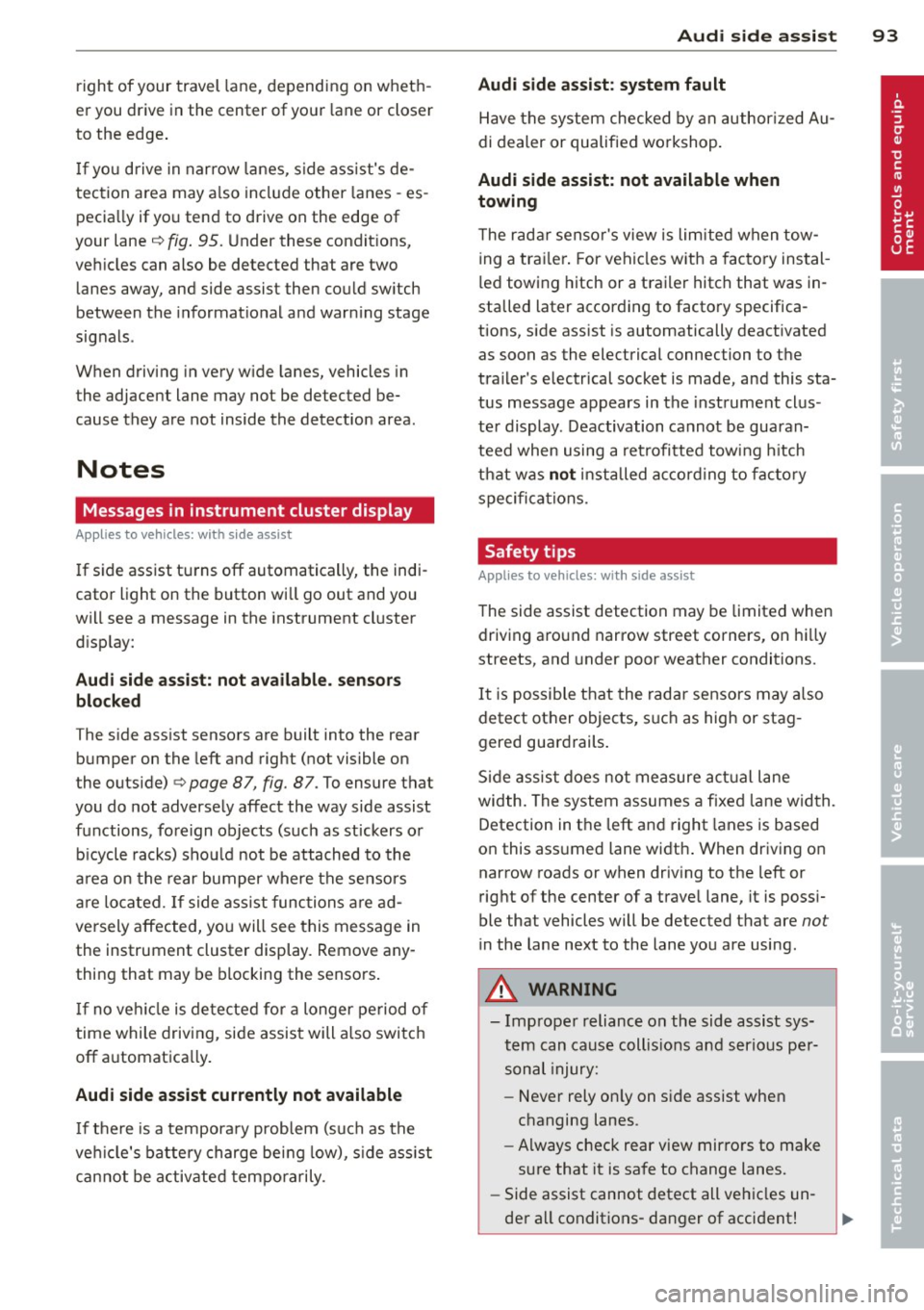
right of your travel lane, depending on wheth ­
er you driv e in the center of your lane or closer
to the edge .
I f yo u drive in narrow lanes, s ide ass ist's de ­
tection area may a lso include other lanes -es ­
pecia lly if you tend to drive on the edge of
your lane¬Ę
fig. 95. Under these condit ions,
ve hicles can also be detected that are two
lanes away, and side assist then could sw itch
between the informat ional and warn ing stage
sig nals .
When driving in very w ide lanes, vehicles in
the adjacent lane may not be detected be­
cause they are not inside the detection area .
Notes
Messages in instrument cluster display
Applies to vehicles: with side assist
If side assist turns off automatically, the indi­
cator light on the button wi ll go out and you
will see a message in the instrument cl uster
d isplay:
Aud i side a ssist : not availab le. s en sors
blocked
T he side assist sensors are built into the rear
bumper on the left and right (not visible on
the outside) ¬Ę
page 87, fig. 87. To ensure that
you do not adversely affect the way side assist functions, foreign objects (such as stickers o r
b icycle racks) shou ld not be attached to the
a rea on the rear bumper where the sensors
a re loca ted.
If side ass ist func tions a re ad­
versely affected, yo u will see this message in
the instrument cluster display. Remove any­
thing that may be blocking the sensors .
If no vehicle is detected for a longer period of
time while driving, side assis t will a lso switch
off a utomatica lly.
Audi side as sist currently not available
If there is a tempora ry problem (such as the
veh icle's battery charge being low), s ide ass ist
cannot be activated tempo rarily.
Audi side a ssis t 93
Audi side assist: system fault
Have the system checked by an author ized Au­
di dealer or qualified workshop .
Audi side assist: not available when
to wing
T he radar sensor's view is limited when tow ­
ing a trai ler . F or vehicles with a facto ry instal ­
led towing hitch or a trailer hitch that was in­
stalled later according to factory specifica­
tions, side assist is automatically deactivated
a s soon as the electrical connection to the
trailer 's electrical socket is made, and this sta­
tus message appears in the instrument clus ­
ter display . Deactivation cannot be guaran­
teed when using a ret rofitted towing hitch
that was
not installed acco rd ing to facto ry
spe cifica tions.
Safety tips
Applies to vehicles: with side assist
T he side assist detection may be limited when
driving around narrow street corners, on hi lly
streets, and under poor weather conditions.
It is possible that the radar sensors may a lso
detect other objects, s uch as high or stag ­
gered guardrails .
S ide assist does not measure act ual lane
width. The system assumes a fixed lane width.
Detection in the left and right lanes is based
on this ass umed lane width . When driving on
narrow roads or when driving to the left or
right of the center of a travel lane, it is poss i­
ble that vehicles will be detected that are
not
in the lane next to the lane you are using .
A WARNING
-Improper reliance on the side assist sys­
tem can cause coll is ions and serio us pe r­
sonal injury:
- Never rely on ly on side assist when
changing lanes .
- Always check rear view mirrors to make
sure that it is safe to change lanes.
- Side assist cannot detect all vehicles un-
der all conditions- danger of accident!
~
Page 97 of 298

Audi drive select Driving settings
Introduction
Aud i drive select makes it possible to experi­
ence different types of vehicle settings in one
ve hicl e. The driver can select three
Comfort,
Auto
and Dynamic modes in the MMI to
switch between a sporty and a comfortable
driving mode.
You can also adjust the setting according to
your preferences in the
individual mode. For
examp le, you can comb ine settings such as a
sporty engine tuning with light steering.
Description
The vehicle setup in each mode depends on
the vehicle's features. The engine, transmis­
sion and steering are always involved . The cor ­
nering light* can also be adjusted . The revers i­
ble safety belt tensioners~
page 187 are
adapted to the dynamic mode.
Engine and transmission
Depending on the mode, the engine and the
transmission respond more quickly or in a more balanced manner to accelerato r pedal
movements. In the sporty dynamic mode, the
transmission shifts at higher RPMs.
Steering
The steering adapts in terms of steering effort
and steering ratios . Indirect steer ing that
moves easily as in comfort mode is especially
suited to long drives on a highway. In con­
trast, dynamic mode provides sporty, direct
steer ing .
The follow ing applies to vehicles with dynam ic
steering*: the steering ratio changes based on
veh icle speed in order to maintain optimum
steer ing effo rt for the driver at all times . Thi s
sets the steering to be less sensitive a t higher
speeds in order to provide improved vehicle
control.
Audi drive select 95
Cornering light*
The cornering light adapts to driving on
curves . The pivoting action and the lighting
are also adapted to the mode.
¬Ęj) Tips
- In some models, the maximum vehicle
speed can only be reached in the
Auto
and Dynamic modes.
- Selecting the
Dynamic mode results in
sporty shifting characterist ics. The
S
gear position engages automatically.
Selecting the driving mode
You can choose between Comfort, Auto, Dy­
namic and Individual .
Fig. 96 MMI: Drive select
.. To se lect the mode , se lect the following in
the MMI:
ICARI function button> Comfort,
Auto, Dynamic or Individual.
You can change the driving mode when the ve­
hicle is stationary or wh ile driving. If traffic
permits, after changing modes, briefly take
your foot off the accelerator pedal so that the recently selected mode is a lso activated for
the engine .
Comfort -provides a comfort-oriented veh icle
setup and is suited for long drives on high­
ways.
Auto -provides an overall comfortable yet dy­
namic dr iving feel and is suited for every day
use .
Dynamic -gives the vehicle a sporty driving
feel and is suited to a sporty driv ing style.
Page 98 of 298

96 Audi drive select
Individual -¬Ę page 96.
Adjusting the Individual mode
A WARNING
Pay attention to traffic when operating Au­
d i drive select to prevent potential risk of
an accident.
You can adjust the vehicle settings to your personal preferences .
.. Se lect : I CARI function button > Set individ­
ual
control button. You can now adjust the
individual systems.
The
Individual driving mode will automatica l­
ly be activated when you have finished config­
uring the settings.
I
Systems
Engine /Transmission
Steering Cornering light*
Belt tensioner*
{1) Tips Comfort
balanced
comfortable
comfortable
-Standard
Your
Individual mode settings are auto­
mat ically stored and assigned to the re­
mote control key being used. The
equipment in your vehicle will determine
which settings you can adjust. The following
table provides an overview of the characteris­
tics of each driving mode.
Auto
ba lanced
balanced
ba lanced
Standard
---~·
---~,
Dynamic
sporty
sporty
sporty
Deployment time
adapted
-
Page 99 of 298

Night vision assistant
Night vision assistant
with detected pedestrian marking
Description
App lies to vehicles: with night v isio n assistant
Fig . 97 D isplay: n ight vision ass istant
"Night v is ion assistant with pedestrian detec­
tion" uses an infrared camera to monitor the
area in front of your vehicle at night. Within
the limits of the system, it can display objects
up to about 1000 feet (300 meters) away. The
heat image of a pedestrian detected by the
camera is shown in the instrument cluster dis­
play
Q fig . 97 . Warm areas appear lighter and
cold areas appear darker .
Pedestrian detection
Applies to vehicles: with n ig ht v ision ass istant
F ig. 98 Display : yellow pedest rian mark in g
Night vision assistant 97
Fig. 99 Display: symbol when infrared image is not
visible
Night vision assistant can detect pedestrians
that are between about 50 and 300 feet (15
and 90 meters) in front of the vehicle, under
ideal conditions . If a pedestrian is detected
when it is dark outside and the vehicle head­
lights are switched on, the pedestrian is high­
l ighted in yellow
Q fig . 98, Q page 98, Gen­
eral information .
If another display such as
navigation replaces the image from the night
vision assistant , the symbo l~,, appears in a
tab
r::',> fig . 99.
(D Tips
If the night vision assistant image does
not appear when the system is switched
on, you can access it with the buttons on
the m ultifunction steering wheel
¬Ępa ge 24.
Page 100 of 298

98 Night visi on assis tant
Pedestrian warning
Applies to vehicles: with night vision assistant
Fig. 100 D isplay : pedestrian warn ing
F ig . 101 D is p lay: pedestrian warning w ith a nother dis ­
p lay
I f a pedestrian is detected i n an area in front
of the vehicle that the system considers criti­
cal, the pedestrian is high lighted in red
q fig . 100 and a warning tone sounds. Th is
area is based on the vehicle speed and steer ­
ing angle. The pedestrian warning prompts
you to pay even closer attention to the area in
front of the ve hicle and to watch out for pe­
destrians.
If another display s uch as the tr ip computer
replaces the image from the night vision as­
sistant, the indicator light turns red when
there is a pedestria n warning
I¬Ę fig. 101.
The pedestr ian war ning I appea rs in the
Head-up Display *.
(D Tips
The pedestrian marking and warn ing tone
can be adjusted in the M MI
r:!) page 99.
General information
Applies to vehicles: with night vision assistant
Fig. 102 Fro nt of th e ve hicle: nig ht v is ion assistant
camera
T he following sit uat io ns may affect the fu nc­
t io n of the n igh t vision assistant sys tem:
- poor visibility such as snow, rain, fog or
heavy road spray
- dirty le ns on the n ight vis ion assistant cam -
era
Make sure the night vision assistant camera
¬Ę fig . 102 is not covered by stickers, depos its
or any other obstructions because that can
prevent the camera from working properly.
For information on cleaning the lens, refe r to
q page
206.
Pedestrian detection depends on the d iffer ­
ence in temperature between the person and
t h e background. Pedestr ians may not be de­
tected if the temperature diffe ren ce is too
small . Th e pedestrian highl ighting feature is
deactivated at tempe ratures above 77 ¬į F (25
¬įC) and when it is light outs ide.
A WARNING
Night vision assistant has limits a nd can­
not always detect pedestr ians. Always pay
close attention to traffic a nd the area
a round your vehicle even when night vision
assistant is sw itched on .
- Night vision assistant can only warn
about people located within the visual
range of the infra red camera. The visual
range corresponds to the image in the in­
s trument clus ter di splay .
- Night vision assistant may not detect
-
peop le and h ighlight them if .,.